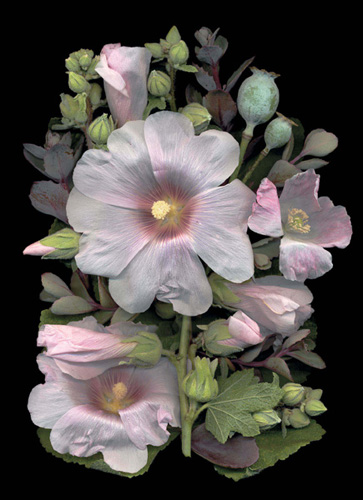
Hollyhock flowers have tissue-paper-like translucent petals. Purple sedum has leathery succulent leaves. Opium poppy petals are filmy, but their fruits are hard orbs covered with a powdery, waxy coating.

In the world of hosta fanciers, the word substance is used to describe the thickness or thinness of leaves. Leaves that are sturdy and stiff are said to have “heavy” or “good substance,” and are often more resistant to slug and snail damage.
One of the most popular hosta varieties is called ‘Sum and Substance.’ It has very large yellow-green leaves that form a flattened mound about eighteen inches high. The leaves emerge yellow in spring and then deepen in color, a morphological state termed viridescence. (Leaves that lighten through the season are said to be lutescent.) In general, golden hostas can tolerate direct sunlight and blue-green darker ones, more shade, but you may have to experiment.
When the leaves of the old standby H. sieboldiana ‘Elegans’ unfurl in the spring, they appear quite blue due to a waxy coating that wears off through the season. The leaves are bumpy and deeply veined. H. tokudama and its offspring H. ‘Love Pat’, and H. ‘Abiqua Drinking Gourd’ capture rain and funnel it down to the soil with rough, cup-shaped, and almost corrugated leaves (called rugose).
Some plants (including hostas) with beefy leaves, stems, and even flowers may be tetraploids having doubled chromosomes. These plants may originate naturally, but more often are made when seeds are exposed to chemicals like colchicum, derived from a fall blooming crocus, or even herbicide residue. The leaves may be twice as thick with flowers larger and more numerous on brawny stalks.
On the other hand, plants with fragile substance may still be appealing. Hollyhocks have nearly filmy petals. And think about the luminous tissue-paper bracts of bougainvillea. Next time you have a chance to stand in an arbor beneath grape leaves or below a Japanese maple, look up toward the sun and contemplate the layers of transmitted light and shadow.
Light transmission is not something customarily thought about in garden design, but it is another characteristic to explore. I have placed several trees, shrubs, and perennials, not for the light that strikes them and is reflected back to my eyes, but rather for the light that passes through them. In late summer, hardy Begonia grandis leaves— green with red veins—planted on the south side of a semi-shaded path look like stained glass. The paperbark maple (Acer griseum) has amber, exfoliating bark. I planted this small tree where the long shafts of the autumn and winter afternoon sunlight make the translucent sheets of bark glow.
Substance is the thickness or thinness of leaves and flowers. Hosta leaves vary, but are generally substantial, for instance in the case of cup-shaped and puckered Hosta tokudama below a sliced leaf of Hosta sieboldii ‘Elegans’ showing its substance in cross-section. The atypical leaves of H. ‘Red October’ has speckled red stems. There are less familiar tiny hostas, as well.
